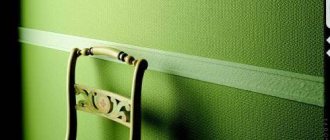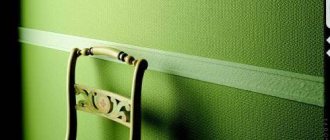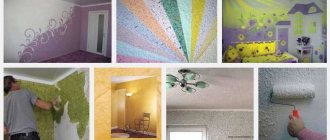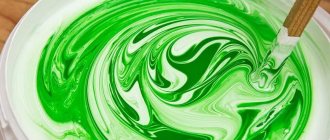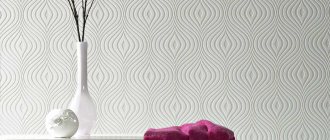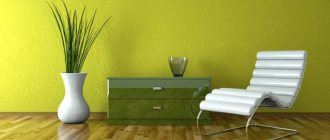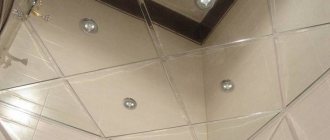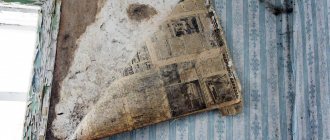Cork wallpaper is not only a cozy decor in eco-style, but also good protection against noise. What is unique about cork wallpaper is that it is 100% natural. They are made from the bark of the cork oak tree, and this bark is removed only once every ten years. After removal, the bark is crushed and applied to a suitable base - usually non-woven material, but simply thick paper is also used.
Cork wallpaper in the interior
For fans of eco-style, cork wallpaper is just a real find. Ecostyle stands for natural colors and materials in the interior, and cork wallpaper is two in one. If you look at the photo you can see how incredible they look.
Designers believe that such wallpapers create an atmosphere of peace and tranquility, and advise those who live in a metropolis to choose this wallpaper. It's like a relaxing effect that residents of cities with a frantic pace of life need.
Cork wallpaper is very warm, wear-resistant and not afraid of moisture. A lot of positive qualities make it possible to use them in any room
Rooms where you can use cork wallpaper:
- Cork wallpaper in the kitchen interior . If you use furniture in natural shades, such wallpaper will be very harmonious. If your kitchen is small, then you can use wallpaper in the form of tiles to cover the walls; the fit will be optimal. If the wallpaper is not impregnated with wax, it is also not suitable for the kitchen - the smells of oil and food will be absorbed.
- Cork wallpaper in the interior of the hall . The walls in the hall or hallway are finished only with materials that can be easily washed and cleaned. Since cork wallpaper is antistatic, dust will not stick to it. This means that such wallpaper can be washed.
- Cork wallpaper in the living room interior . Typically, designers agree that the central wall can be covered with contrasting wallpaper, and the other three with cork. Cork is not always suitable for all four walls, but in this combination it looks great. The color of contrasting walls can be, for example, chocolate.
- Cork wallpaper in the bathroom . For those who are tired of cold tiles. Cork creates the illusion of warmth, which is often lacking in the bathroom. Rest assured that cork is resistant to mildew, mildew and other side effects of high humidity.
Related article: How to cover a door with clapboard: recommendations, advantages of the material
Cork in the interior can be used as a decorative panel or completely functional wall panels
In general, it can be noted that cork is a fairly versatile material, which, due to its naturalness, looks great in any room. On any wall they can be organic to other interior elements.
Design of rooms with cork wall covering (video)
How to glue cork backing to the wall?
It is possible to reliably and efficiently fix the cork covering only with the help of a properly selected adhesive composition.
Henkel has developed a special composition? contact adhesive Moment Cork. The preparation is quick-setting and has a high initial bonding force, therefore it is suitable for installing the coating on both horizontal and vertical surfaces. It can be used to fix floor and wall cork coverings: sheet and roll substrates, as well as cork moldings.
We offer to buy Moment Cork glue 1 liter and 5 liters at an attractive price on our website.
The composition fits perfectly on metal, plastic, rubber, leather, wood and even felt substrates. After drying, it forms an adhesive joint that is resistant to moisture, low temperatures, as well as weak acids and alkalis. Suitable for use not only indoors, but also on a glazed balcony.
Glue Moment Cork is non-toxic and does not contain toxic solvents.
Is it possible to glue cork wallpaper onto wallpaper?
What is important is not the fact that the wallpaper is pasted, but the ideal readiness of the walls for gluing. It doesn’t matter whether you bought wallpaper in rolls or in tiles, you still need to stick it on a flat wall.
How to glue cork wallpaper - technical instructions:
- Walk along the wall with lighthouse starting putty or plaster;
- Next, the surface needs to be primed, and all defects in the walls must be repaired;
- It is impossible to bend cork wallpaper, as well as to glue it overlapping, but only end-to-end;
- You need to cut the wallpaper with strong scissors;
- Before gluing, the wallpaper is cut into strips; you need to let them rest before it comes to pasting the walls;
- Markings on the wall are mandatory - draw a vertical line, glue from it in both directions so that the cutting is the same on all sides.
No glue is used to make such a fabric, since the cork itself releases adhesives during pressing.
If you look at the reviews, it becomes clear that the choice of glue is of great importance.
Types of cork covering
Cork is glued to walls made of a wide variety of materials. There are the following types of coating: rolls, wallpaper, liquid wallpaper, segments, tiles.
Wall
Each cork panel has a tongue and groove design, making them easy to install. But the cork covering is glued directly to the wall, and not to the sheathing.
Ceiling
Most often, the ceiling material is white, but there may also be others, for example, pastel colors. Panels (slabs) of small thickness. For finishing rooms with a high degree of air humidity, it is recommended to purchase cork slabs that are treated with wax. But if the material is ordinary, then one layer of colorless varnish is applied to the ceiling tiles.
Cork ceilings do not deform due to sudden temperature fluctuations and increased humidity.
Rolled decorative cork
Rolled decorative cork is made of 2 layers: a substrate - medium-sized and compressed cork chips, and a layer of cork veneer is applied on top.
This room decoration is created without the use of synthetic binders. The material has no finishing, which is why, after gluing it to the walls, it is covered with heated wax or varnish. Rolled cork is very thin - 1.2-2 mm, so it is elastic and easy to combine with wallpaper. It does not swell with water and does not peel off, which is why it is excellent for rooms with high air humidity.
Another advantage of the material is that there are no horizontal seams when gluing, the result is an absolutely uniform pattern.
Liquid coating
It is made from 96% natural bark chips and 4% acrylic based binder. It has a large number of tiny pores saturated with nitrogen and oxygen, suberin juice and resins are present, so it is waterproof.
Cork wallpaper in rolls in the interior
Cork wallpaper is created as follows: a paper canvas is treated with colorless or varnished in any shade, covered with thin agglomerated veneer (up to 1 mm), leaving unfilled spaces. Cork wallpaper has many pores, which is why they do not allow sound and heat to pass through. They are very light, but elastic, so they can easily withstand a variety of loads. They are antistatic, do not collect dust, and have antibacterial properties. We sell cork wallpaper in natural colors and with various colored inclusions. As a rule, rolls are sold 10 m long. The material is very thin - 3 mm. And its width: 300x600 mm or 300x1000 mm. They can retain their structure and color on the wall for up to 10 years.
Cork tiles for interior decoration
Cork slabs are created by grinding the bark of a cork oak tree into pieces of 0.2-8 mm.
Plates can be made of 1 or 2 layers. When preparing slabs from 1 layer, the granulated cork is pressed, then wax is applied to it to give greater strength. As a rule, the substrate is quite thin, only 2 mm. When creating slabs of 2 layers, first coat the main layer of pressed cork with glue made from natural substances, then attach the cork veneer. Usually the base of the slab is painted in some color. Standard wall cork tiles: 3x300x300 mm or 3x600x300 mm (thickness x length x width).
You can apply paint to the top of the tiles, followed by wax. The service life of cork tiles is 10-30 years.
With or without spraying
You can also purchase a mixture that is sprayed on the walls. It has excellent adhesion to other compounds. It can be painted in any color, both bright and pastel. There are 3 types of such cork, depending on its application: liquid cork for roofing, facade and fire-resistant.
The material is applied by spraying it horizontally or vertically, thus hiding wall defects. A layer of liquid cork 3 mm thick will hide almost all defects caused by shrinkage of the building. The composition will also serve as a building insulator and will not allow water or sound to pass through.
Cork wallpaper glue
There are also some nuances here. You can buy expensive acrylic glue, it is easy to use, and a person inexperienced in repairs can figure it out. But experts advise buying simple contact adhesive; you will have to tinker with it, but the wallpaper that is attached to it will definitely never come off.
Just don’t use absolutely any contact adhesive. The packaging should say “for heavy wallpaper.”
Contact glue will work better if you press the wallpaper longer against the wall surface
Related article: How to make a flower bed or flower garden
Do not use PVA glue or other adhesives that contain water. Nitro glue is also not recommended; it is unsafe for human health.
Oriental style interior ideas
If you have chosen an oriental style to create the interior of your apartment or country house, then you may find the original ideas useful, which we will discuss in this article. The decoration options we offer are suitable for decorating a kitchen, dining room, veranda, terrace, relaxation room in a sauna, some elements can also be used in the living room.
Suspended ceiling made from bamboo stems
If the ceiling area is large enough, then to construct the frame you will need wooden beams and timber (or a large diameter dowel). For a small area (for example, a veranda or corridor), one beam will be enough. The beam can be made from four wooden boards, then it will be lighter and cheaper in cost. As an economical option, you can take polyurethane beams that imitate wood.
Beams and beams are installed at some distance from the ceiling along the perimeter of the room. The distance will depend on the diameter of the bamboo stems you choose and whether you will be lighting the ceiling.
The beams are attached to the wall on a support table (block). Another option is to use a hammer drill to make two recesses on opposite walls; the depth of one recess should be greater than the other so that the beam can be inserted.
Typically, when installing such a ceiling, several lighting sources are used: the first is lamps installed behind the suspended ceiling, and the second is brighter lighting.
When decorating a large area, a suspended ceiling is installed only at the edges of the room, usually one and a half to two meters. The usual ceiling remains in the center, otherwise the room will look quite gloomy.
The thickness of bamboo stems can be any. In this case, you can take stems with the same thickness or alternate stems with different diameters. Bamboo stems can be laid one at a time or tied with a cord in bundles of several pieces.
Lamps
Ordinary ceiling and wall lamps can be easily styled to suit your chosen interior. To do this, you need to remove the lampshade from the lamp and replace it with a lampshade woven from a rod (for example, willow).
You can make a frame from metal wire and decorate it with jute rope. The cord or rod on which the lamp is suspended is decorated with an artificial vine or the same rope.
Wall decoration
For most oriental styles, it would be appropriate to use niches in the walls, which can be either rectangular or with a domed top. Such niches are often made with lighting; a decorative vase is installed in the niche; you can hang a decorative plate or panel.
An unusual option is a closed niche into which a lattice of thin wooden slats is inserted.
If a niche is made during the construction of a house, then it can be arranged in brick or stone masonry.
The simplest and most economical option for constructing a niche is to cover the walls with plasterboard or gypsum fiber sheets (GVL, GVLV).
The surface of the walls can simply be covered with light-colored plaster, but the most interesting option is to imitate ancient masonry. To do this, they usually use artificial stone (which is lighter and cheaper than natural stone) or a thick layer of plaster on which a pattern is made. The second option requires certain skills and craftsmanship, in addition, it is more labor-intensive.
Cork backing for wallpaper
What is a wallpaper backing - it is a canvas that is used as a middle layer. The middle layer means a material whose task is to level and increase adhesion (adhesion) between the wall surface and the finishing coating.
Why is such a layer needed:
- It perfectly compensates for all base defects;
- Serves as a material for additional adhesion;
- Helps quickly prepare the wall for gluing.
In addition to all the above qualities, cork backing is also an excellent insulation material, as well as a sound insulator.
A cork backing is not used only if the topography of the wall protrudes strongly forward.
If you look at the photo of the cork backing, you will see that it is very attractive in appearance; it is often used as a self-sufficient finishing material.
There are regular substrates, without additional properties. But there are also substrates that “know how” to dampen vibrations and are sound insulators.
Cork backing (video)
Features of cork coating
Cork backing (it’s very easy to stick it on a wall instead of wallpaper) performs a number of useful functions:
- with its help you can smooth the walls without resorting to a lengthy leveling process using additional materials and mixtures;
- it has a high degree of sound insulation, which is extremely important for large areas or rooms with thin walls;
- the airiness of the material layers does not allow moisture to be retained, so condensation does not form when there is a difference in temperature or humidity;
- Cork can be used as a layer between the wall and wallpaper to increase adhesion.
Important! Cork material undergoes special treatment to eliminate the possibility of fire. Therefore, cork backing can be attached to walls and other surfaces in compliance with fire safety standards.
Self-adhesive cork wallpaper
Self-adhesive cork wallpaper is an innovation in renovation. What’s so great about them is that they stick to the wall just like the more familiar self-adhesive film.
Imagine: the walls to be glued are smooth, clean, even. You have measured them and start cutting the sheets. Along the width of the wallpaper, you need to separate a three-centimeter protective layer. The open part of the wallpaper is glued to the wall, and the protective film is removed from the entire canvas, the sheet is glued completely.
If bubbles have formed under such wallpaper, this can be eliminated with a damp cloth. If the air still does not come out, you can make a small puncture with a needle, and then iron the wallpaper again with a cloth.
The self-adhesive type of cork wallpaper has a particularly thin structure, making it more versatile: it can be used to cover walls, doors, decorate furniture, design panels, etc.
Related article: How to make a mirror ceiling with your own hands?
Decorative rope in the interior: 10 original ideas for use
How to decorate a house with decorative rope
The most popular method of using decorative rope for a log house is additional insulation of inter-crown seams and end cuts. Combining perfectly with any type of insulation (wood sealants, natural caulking), ropes enhance their thermal insulation function and at the same time protect the material itself from negative factors.
Sidebar: The use of decorative rope is simply mandatory if the log house is caulked with natural materials: flax, moss, tow. Natural caulking “covered” on top with a rope will be reliably protected from birds and insects.
Using rope as a decorative element
A wooden house is an excellent field for realizing any design fantasies. Today, houses in country, Victorian and eco-style are at the peak of popularity. Decorative rope in the interior is an excellent addition to the design of all of the above stylistic solutions, as evidenced by numerous photos on the Internet. Decorative rope nets that can be placed on walls, ceilings, and floors look very stylish and impressive in wooden buildings.
Making rope railings
Decorative twine can be used to decorate handrails by wrapping them or completely replacing handrails with ropes. Handmade lovers will definitely appreciate the ease of doing this work and, of course, the result: the rope railings look amazing!
Creation of decorative objects
Manila and jute ropes are a fairly flexible material, thanks to which they can be used to create unusual and original things: rugs, wall panels, pendants for flower pots, hot stands, etc. Today on the Internet you can find many instructions and video tutorials, following which you can easily create an exclusive, “author’s” decoration for your home.
Decoration of interior items: mirrors, clocks, floor lamps
If you have not yet tried to create something yourself from decorative rope and doubt your abilities, start with a simpler task: decorate existing things with rope. Rope is great for decorating various items: wall clocks, photo frames, lamps and floor lamps, flower pots, mirrors, etc. Almost any thing can be decorated with decorative rope, and all work, as a rule, is carried out according to the same scheme: by wrapping the object with rope.
Creation of suspended structures
Large diameter ropes are highly durable, so they are often used to create hanging beds, swings, hammocks, and shelves. Agree that it will be very pleasant to spend time in a hammock made by yourself or in a gently rocking “lulling” bed.
Zoning of premises
You can divide a room into separate zones in a wooden house using the same decorative ropes. With a rope curtain or partition, which can actually be made in just a few hours, you can separate one room from another, while the entire area of the home will maintain visual integrity, thanks to the “transparency” of the structure.
Design of designs for children
Is it possible to imagine a country cottage or country house without a separate secluded corner, completely at the disposal of the children? It could be a children's playhouse, a wooden slide boat, or a whole playground with ropes, beams, and swings. Using decorative ropes, you can give any children’s structure a “fairytale” look (Baba Yaga’s hut, a pirate ship, etc.).
Curtain decor
Decorating curtains with decorative rope is a fashionable trend today: ropes are used to create tiebacks and loops, to decorate cornices, to decorate window openings, etc.
Furniture decor
Do you have a lot of old furniture in your dacha that looks, to put it mildly, “shabby”? Decorative rope will help solve this problem: tables and stools, armchairs and poufs will simply be transformed with the help of ordinary rope and glue, and besides, you will become the owner of exclusive furniture that you cannot buy in a store for any money.
Popular brands of cork wallpaper
There are several brands that get the best reviews. One of these is Ibercork. Typically, such wallpapers have light colors - beige, yellow and their shades.
Cork wall coverings from the best manufacturers can be found in the Leroy Merlin network of construction hypermarkets.
Sometimes such wallpaper is coated with colored or neutral varnish
Wallpaper from traffic jam in Leroy Merlin:
- They are sold both in the form of cork tiles and in the form of rolls.
- Cork tiles typically weigh 3.3 kg. But only the heavy weight can be considered a drawback; the performance characteristics of the tiles are excellent.
- Cork rolls in Leroy Merlin are not electrified, which means they are not afraid of dust, bacteria or microbes.
Leroy offers many colors and shades from leading manufacturers on the world market, which, of course, makes this coating more attractive to choose from.
Bathroom interiors in modern style
Individual layouts and interiors of bathrooms in Art Nouveau style
The use of modern home decoration methods helps transform an ordinary interior into a comfortable and extremely harmonious space. To comply with the Art Nouveau direction, the bathroom design can have either a strict appearance with right angles of multi-level ceilings and wall bas-reliefs, or an oval appearance.
Art Nouveau is a style that originated in the 19th – 20th centuries. The movement originated in France, in Paris, and was called Art Nouveau. A large store opened by a talented art critic in 1895 had a similar sign. Then an unknown architect from Belgium decided to decorate four trading floors in the Art Nouveau style. The owner of the design center failed to make a fortune from retail sales and soon closed it.
It was the first metropolitan retail premises that gave impetus to the new direction, which soon spread throughout Europe. In each European corner the style had its own name, but the main characteristics and principles were the same. By the 1900s, Art Nouveau began to subside and lost its mass appeal. And by the beginning of the First World War, supporters of this style had practically disappeared. But today the trend is increasingly found in the interior design of residential premises.
Cork wallpaper in the interior (photo)
Advantages of using the material
Gluing cork backing to the wall instead of wallpaper provides a number of advantages:
- Durability. Cork does not become obsolete, and its service life can reach hundreds of years.
- The cork covering can be dismantled countless times, while it will maintain its integrity and characteristics.
- Wear resistance. Due to the elasticity of the material, low-intensity mechanical impacts on the surface go unnoticed.
- Resistant to temperature changes. When heated or cooled, the cork structure retains its original appearance and strength.
- Cork perfectly hides defects in the structure of walls.
- Both the technical type of the material and the agglomerate do not allow current to pass through; in addition, they are not capable of accumulating static electricity.
- The inability to accumulate microorganisms and fungal spores inside its structure determines the antiseptic properties of the material. And suberin, which is used to treat cork, acts as an antiseptic.
- Thanks to sanitary treatment at the production stage, the cork substrate (it is often glued to the wall instead of wallpaper) is unattractive to small rodents and tree pests.
- No aggressive chemical compounds are used in the production of the material, and therefore it can be considered hypoallergenic and environmentally friendly.
- In case of possible exposure to fire, the cork surface does not ignite, but can only smolder, and there are no toxic emissions.
- Cork wallpaper effectively absorbs noise and retains heat.
Necessary tools for installing plugs on walls
Is it possible to glue cork backing to walls without using specific equipment? For installation you will need quite simple tools:
- pencil or marker for marking;
- durable ruler, more than 1.5 meters long;
- roulette;
- fine-toothed spatula;
- sharp stationery or construction knife;
- ordinary solvent;
- masking tape;
- glue;
- gloves to protect your hands and a rag to remove excess adhesive.
Material release forms
Reviews about using cork backing on the wall instead of wallpaper are mostly positive. As a material for wall decoration, you can take one of the produced forms:
- Cork sheets, which can be found up to 1 cm thick and 610-915 cm long.
- Sheets in rolls are quite voluminous, but the thinnest option, in which the length reaches 10-25 meters. The thickness of the cork is 0.2-0.4 cm.
- Cork panels. The release form is convenient for installation and is also convenient for transportation.
To use a cork backing on a wall under wallpaper, you should choose a material with a lower density, called cork agglomerate. Another type of this material is more dense and can be used as an independent finishing agent.

